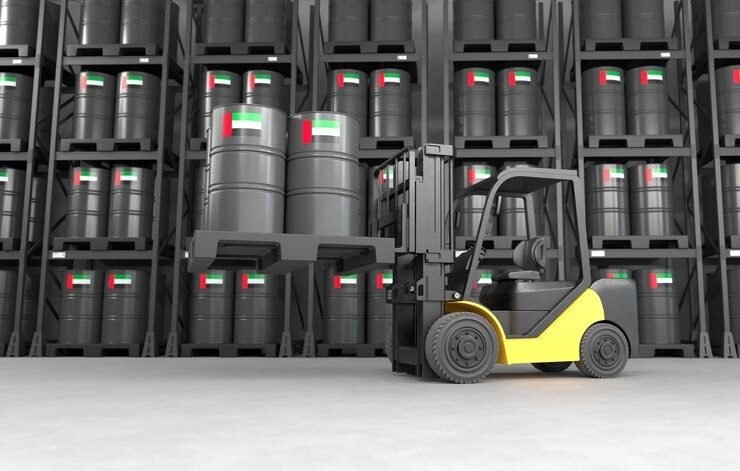Maximising Warehouse Space: A Guide to Overcoming Storage Challenges

Efficient warehouse management is crucial for businesses to succeed. One of the most common challenges warehouse managers face is optimising storage space. Limited space can lead to inefficiencies, delays, and increased costs. You can make the most of your warehouse space and improve overall operations with the right strategies.
This blog post explores practical ways to tackle warehouse space problems, focusing on practical solutions and actionable tips. For example, you can use very narrow aisle forklift trucks to access the places that are generally difficult to reach.
Understanding the Challenge: Before diving into solutions, let’s first understand the primary issues contributing to warehouse space constraints. Many warehouses need more aisle space, making manoeuvre traditional forklift trucks difficult. This limitation hinders the efficient movement of goods and restricts the utilisation of vertical space for storage. Additionally, fluctuating inventory levels and poor organisation can further exacerbate space constraints. Forklift rental companies may help you overcome this issue through their narrow aisle forklift trucks, available at affordable rental services.
Optimising Warehouse Space with Very Narrow Aisle Forklift Trucks
Very narrow aisle forklift trucks offer a solution to the challenge of limited aisle space. These specialised forklifts operate in narrow aisles, allowing for tighter racking configurations and maximising storage capacity. By utilising VNA forklift trucks, warehouse managers can effectively navigate narrow aisles and access inventory stored at greater heights.
Critical Strategies for Optimising Warehouse Space:
1. Implement Vertical Racking Systems:
● Utilise vertical space by installing tall racking systems.
● Invest in adjustable pallet racking to accommodate varying inventory sizes.
2. Adopt Just-In-Time Inventory Management:
● Implement a just-in-time (JIT) inventory system to reduce excess stock.
● Minimise storage space requirements by ordering inventory as needed.
3. Utilise Pallet Flow Racking:
● Implement pallet flow racking systems to improve accessibility and space utilisation.
● FIFO (First In, First Out) flow ensures efficient inventory rotation.
4. Invest in Automated Storage and Retrieval Systems (AS/RS):
● Implement AS/RS technology to maximise vertical space and streamline operations.
● Reduce reliance on manual labour and optimise storage density.
5. Partner with Forklift Rental Companies:
● Collaborate with forklift rental companies to access specialised equipment, such as VNA forklift trucks.
● Opt for short-term rentals to meet temporary or seasonal demands without long-term commitments.
6. Streamlining Inventory Management Processes:
● Implement barcode or RFID tracking systems to monitor inventory levels accurately.
● Conduct regular audits and inventory counts to identify obsolete or slow-moving items.
● Optimise picking and packing processes to minimise time spent searching for items and reduce congestion in aisles.
7. Enhancing Warehouse Layout and Design:
● Conduct a thorough analysis of the warehouse layout to identify inefficiencies and opportunities for improvement.
● Designate specific receiving, storage, picking, and shipping areas to streamline workflow.
● Optimise aisle widths and traffic flow to accommodate the movement of VNA forklift trucks and minimise congestion.
8. Implementing Space-saving Packing Techniques:
● Explore alternative packaging solutions to reduce the footprint of individual items.
● Utilise stackable containers, collapsible crates, and nested pallets to maximise storage density.
● Optimise palletisation techniques to minimise wasted space and ensure stable stacking.
9. Leveraging Data Analytics for Decision-Making:
● Utilise warehouse management software to analyse data and identify trends related to inventory turnover, storage capacity, and picking efficiency.
● Make data-driven decisions regarding inventory placement, replenishment strategies, and space allocation.
● Continuously monitor key performance indicators (KPIs) to measure the effectiveness of warehouse space optimisation efforts and identify areas for improvement.
10. Employee Training and Engagement:
● Provide comprehensive training to warehouse staff on the safe and efficient operation of VNA forklift trucks and other equipment.
● Foster a culture of continuous improvement by encouraging employees to identify and suggest solutions for space optimisation challenges.
● Recognise and reward employees who contribute innovative ideas or demonstrate exceptional performance in optimising warehouse space.
11. Cross-Docking Operations:
- Implement cross-docking strategies to minimise storage time and space requirements.
- Utilise staging areas for incoming shipments to be directly loaded onto outbound transportation, reducing storage needs.
- Streamline processes to ensure efficient transfer of goods from inbound to outbound vehicles.
12. Dynamic Slotting Techniques:
- Employ dynamic slotting algorithms to continuously optimise the placement of goods within the warehouse based on factors such as demand patterns and SKU characteristics.
- Group frequently picked items closer to the picking area to minimise travel time.
- Adjust slotting based on seasonal demand changes or promotions to maximise efficiency.
13. Zone Picking and Batch Picking:
- Implement zone picking where each picker is assigned to a specific zone or area of the warehouse to minimise congestion and optimise picking routes.
- Utilise batch picking for orders containing multiple SKUs by consolidating picking tasks, reducing travel time, and improving efficiency.
- Utilise pick-to-light or voice-directed picking systems to enhance accuracy and speed in zone and batch picking operations.
14. Warehouse Slotting Optimization Software:
- Invest in warehouse slotting optimisation software that uses algorithms to analyse data and recommend optimal slotting configurations.
- Utilise software features such as heat maps to visualise inventory flow patterns and identify opportunities for improvement.
- Continuously refine slotting strategies based on real-time data and performance metrics provided by the software.
15. Implementing Lean Principles:
- Apply lean principles such as 5S (Sort, Set in order, Shine, Standardise, Sustain) to maintain a clean, organised, and efficient warehouse environment.
- Implement visual management techniques such as colour-coded labels and floor markings to enhance organisation and reduce errors.
- Foster a culture of continuous improvement by empowering employees to identify and eliminate waste in warehouse processes.
16. Utilise Mezzanine Floors:
- Install mezzanine floors to create additional storage space without expanding the footprint of the warehouse.
- Utilise mezzanine floors for storing lightweight or smaller items, freeing up ground-level space for bulkier inventory.
- Ensure mezzanine floors are designed and engineered to support weight and load requirements for stored goods and equipment.
17. Optimise Dock Operations:
- Streamline dock operations by implementing efficient loading and unloading procedures to minimise dwell time and maximise throughput.
- Utilise dock scheduling software to coordinate inbound and outbound shipments, optimising dock usage and reducing congestion.
- Implement dock door assignment strategies based on shipment priority, carrier schedules, and warehouse capacity to ensure smooth operations.
Conclusion:
Efficient warehouse space management is essential for enhancing productivity and reducing operational costs. Businesses can overcome space constraints and optimise their warehouse operations by leveraging innovative solutions like narrow aisle forklift trucks and strategic storage systems. Embracing modern technologies and collaborating with industry partners, such as forklift rental companies, enables organisations to adapt to evolving demands and stay competitive in today’s dynamic marketplace.
Prioritising warehouse space optimisation is key to unlocking greater efficiency and profitability. By implementing the strategies outlined in this blog, you can transform your warehouse into a well-organised and highly productive facility capable of meeting the demands of modern supply chain management.


